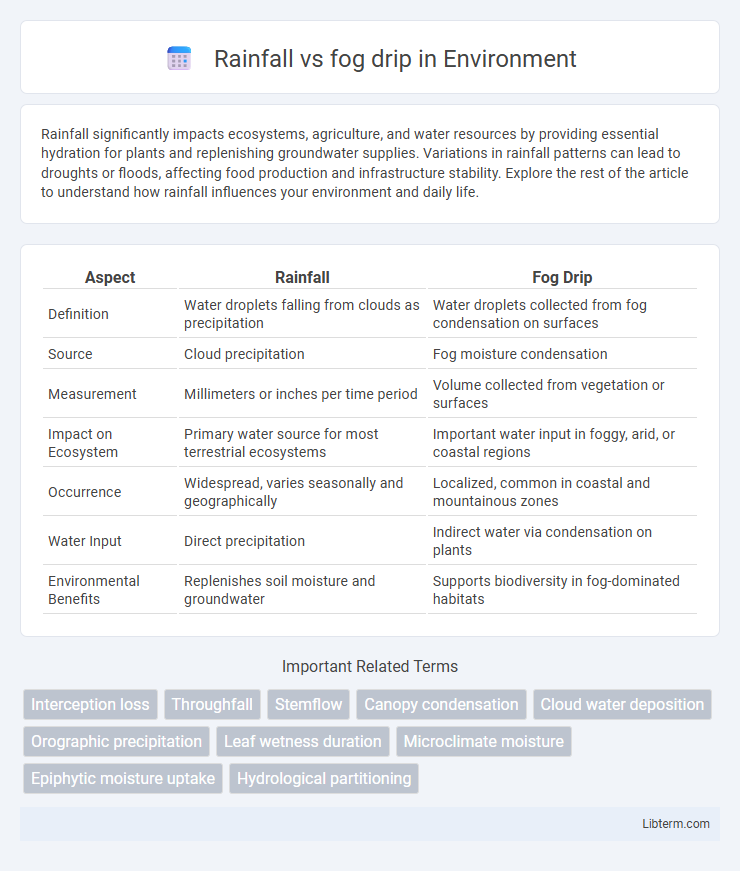Rainfall significantly impacts ecosystems, agriculture, and water resources by providing essential hydration for plants and replenishing groundwater supplies. Variations in rainfall patterns can lead to droughts or floods, affecting food production and infrastructure stability. Explore the rest of the article to understand how rainfall influences your environment and daily life.
Table of Comparison
| Aspect | Rainfall | Fog Drip |
|---|---|---|
| Definition | Water droplets falling from clouds as precipitation | Water droplets collected from fog condensation on surfaces |
| Source | Cloud precipitation | Fog moisture condensation |
| Measurement | Millimeters or inches per time period | Volume collected from vegetation or surfaces |
| Impact on Ecosystem | Primary water source for most terrestrial ecosystems | Important water input in foggy, arid, or coastal regions |
| Occurrence | Widespread, varies seasonally and geographically | Localized, common in coastal and mountainous zones |
| Water Input | Direct precipitation | Indirect water via condensation on plants |
| Environmental Benefits | Replenishes soil moisture and groundwater | Supports biodiversity in fog-dominated habitats |
Understanding Rainfall and Fog Drip
Rainfall involves the direct precipitation of water droplets from clouds, contributing significantly to soil moisture and surface water replenishment. Fog drip occurs when fog droplets condense on vegetation and surfaces, subsequently dripping to the ground, often providing moisture in environments where rainfall is scarce. Understanding the distinct roles of rainfall and fog drip is essential for managing ecosystems reliant on variable water inputs.
Key Differences Between Rainfall and Fog Drip
Rainfall involves precipitation composed of liquid water droplets falling from clouds, typically measured in millimeters or inches over time, while fog drip occurs when water droplets from fog condense on vegetation and subsequently drip to the ground. Rainfall contributes significantly to surface water and soil moisture, whereas fog drip plays a critical role in maintaining moisture in arid and coastal ecosystems where rainfall is minimal. Unlike rainfall, which can be quantified with rain gauges, fog drip requires specialized collection methods such as leaf or mesh collectors to estimate water input effectively.
The Science Behind Rainfall Formation
Rainfall forms through the condensation of water vapor into droplets within clouds, which grow heavy enough to fall due to gravity, influenced by atmospheric temperature and humidity levels. Fog drip occurs when tiny water droplets in fog accumulate on surfaces like leaves, eventually dripping down and supplementing rainfall in ecosystems, especially in coastal and mountainous regions. The key difference lies in rainfall originating from cloud precipitation processes, while fog drip results from direct condensation on surfaces from low-lying clouds or fog.
How Fog Drip Occurs in Nature
Fog drip occurs when fog condenses on the surfaces of leaves and branches, causing water droplets to form and eventually drip to the ground. This process happens in areas where fog frequently envelops vegetation, such as coastal forests or mountainous regions, contributing significant moisture even in the absence of rainfall. Fog drip plays a crucial role in sustaining ecosystems by supplementing soil moisture and supporting plant growth during dry periods.
Measuring Rainfall and Fog Drip
Measuring rainfall involves the use of rain gauges that collect and quantify precipitation in millimeters or inches over a set period, providing accurate data for hydrological studies. Fog drip measurement requires specialized devices like fog collectors, which capture water droplets from fog onto mesh screens, allowing researchers to estimate the volume of water deposited in ecosystems where fog is a significant moisture source. Both methods are critical for understanding water input in diverse environments, especially in regions where fog drip can rival or exceed rainfall amounts.
Ecological Benefits of Rainfall and Fog Drip
Rainfall delivers critical hydration to ecosystems, replenishing soil moisture and supporting plant growth, which in turn sustains biodiversity and regulates microclimates. Fog drip supplements water availability in arid and coastal regions by condensing moisture from fog onto vegetation, reducing drought stress and enhancing habitat resilience. Both rainfall and fog drip play vital roles in maintaining ecosystem productivity, water balance, and supporting species adapted to diverse environmental conditions.
Impact on Water Resources and Aquifers
Rainfall directly replenishes surface water and groundwater aquifers, significantly contributing to freshwater availability and ecosystem sustainability. Fog drip, occurring when fog condenses on vegetation and drips to the ground, supplements water input in arid and fog-prone regions, enhancing soil moisture and aiding aquifer recharge where rainfall is scarce. Both processes are critical for maintaining water balance, with rainfall dominating in typical climates and fog drip providing essential hydration in specialized environments.
Rainfall vs Fog Drip: Regional Variation
Rainfall and fog drip exhibit significant regional variation influenced by local climate and topography, with fog drip playing a crucial role in coastal and mountainous environments where persistent fog occurs. In areas like the Pacific Northwest, fog drip can contribute up to 30-40% of total moisture input, supplementing rainfall during dry seasons and supporting unique ecosystems. Contrarily, inland and arid regions rely predominantly on direct rainfall, where fog drip contribution is minimal or absent due to lower fog frequency.
Role in Sustaining Forest Ecosystems
Rainfall provides essential water that directly nourishes forest soils and supports tree growth, while fog drip captures moisture from clouds, supplementing water availability during dry periods. Fog drip contributes significantly to sustaining cloud forests by maintaining high humidity and reducing water stress for epiphytes and understory plants. Together, rainfall and fog drip create a microclimate that sustains biodiversity and ecosystem productivity in forest environments.
Future Trends: Climate Change and Water Inputs
Climate change is expected to alter rainfall patterns and fog drip intensity, significantly affecting water inputs in ecosystems reliant on these sources. Increased temperatures may reduce fog frequency and moisture capture, diminishing fog drip contributions critical in arid and coastal environments. Predictive models suggest shifts in precipitation distribution will require adaptive water management strategies to sustain biodiversity and agricultural productivity.
Rainfall Infographic

 libterm.com
libterm.com